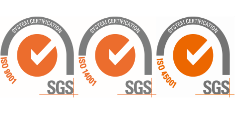Gripfibre
MICROSURFACING WITH HIGH SKID RESISTANCE


Microsurfacings have proven their effectiveness in a large number of road projects and represent an excellent compromise between technical characteristics and cost. Eurovia has developed a "second generation" microsurfacing which more than confirms this technical performance track record, especially in terms of skid resistance and durability.

GRIPFIBRE is a 0/6 or 0/10 (sometimes 0/4 slurry) continuous or gap graded microsurfacing with added fibres. It is applied as a wearing course in thicknesses of approximately 1 cm.
The innovative aspect of the invention is the addition of synthetic fibres in the formulation. They make it possible to apply gap graded formulations without risk of segregation and thus ensure lasting surface texture. They reduce the risk of emulsion drainage and loose chippings when the road is re-opened to traffic.
GRIPFIBRE is manufactured and laid by a single self-propelled machine which transports and stores the constituent materials, proportions them, mixes them and spreads them over large widths on the roadway. The equipment used by Eurovia is fitted with extending levellers with variable spreading widths. The most modern machines use front-end loading and continuous feed of both aggregate and liquid components and thus achieve very high laying rates.
GRIPFIBRE is usually applied in a single layer on properly shaped substrates. A dual layer system is possible in cases of limited substrate deformation (less than 2 cm under a 3 m straight edge). If there are larger deformations, prior reshaping or cold planing are required.

The amounts applied to an appropriate high-quality substrate are, respectively, approximately 13 kg/m2 for a 0/6 grading and 10 kg/m2 for a 0/10 formula.
GRIPFIBRE is patented, as is the fibre proportioning system. The process, with an EMULPLAST EC binder, is covered by Avis Technique No. 69 (currently in the process of renewal).
GRIPFIBRE is a registered trademark.
CAREFULLY SELECTED MATERIALS

Aggregates used in GRIPFIBRE come from hard rock quarries which the company carefully selects for the purpose. They meet the same requirements as the aggregates used in hot mixes for wearing courses (NF P 98-150 standard).
The GRIPFIBRE binder is usually an EMULVIA GRIP cationic modified bituminous emulsion with slow and controlled breaking properties. The use of pure bituminous emulsion is confined to roads with low traffic volumes.
The essential element of the GRIPFIBRE formulation is the fibres it contains. These are organic in origin and have a length of over 4 mm. Their proportions, which depend on the proportion of aggregate, result in the "reinforcement" of GRIPFIBRE by several million fibres per m2.
The other additives used in the formulation (cement or lime and aqueous-solution surfactant) control the setting of the emulsion and adapt it to worksite conditions.
LASTING SKID RESISTANCE
| Depth by sand patch test (NF P 98-216-1) |
|
|---|---|
| continuous 0/6 | 0.6 á 0.8 mm |
| discontinuous 0/6 | 0.9 á 1.4 mm |
| discontinuous 0/10 | 1.3 á 1.8 mm |
| Measured after 1 years of traffic T1. |
|
GRIPFIBRE can be used for all types of traffic. It waterproofs roadways and provides them with durable skid-resistance.
The macrotexture is high in new pavements and does not suffer a marked reduction over time.
Skid resistance is also high in newly laid surfacings and changes very little over time.
The following table shows average longitudinal friction coefficient (CFL) values (NF P 98-220-2 standard) measured on representative gap graded formulation GRIPFIBRE surfaces.
|
0/6 |
0/10 |
|||
| Section |
|
|
||
| Traffic |
|
|
||
| CFL at | 1 year | 3 years | 1 year | 5 years |
| 40 km/h | 0,55 | 0,55 | 0,51 | 0,41 |
| 60 km/h | - | - | 0,43 | 0,38 |
| 80 km/h | - | - | 0,39 | 0,34 |
| 90 km/h | 0,43 | 0,37 | - | - |
| 120 km/h | 0,36 | 0,33 | - | - |
THE SUPERIOR MICROSURFACING

GRIPFIBRE achieves skid resistance and durability levels previously thought impossible in microsurfacings. It can be used for both construction and maintenance of roads of all traffic loads.
It is installed at high laying rates using compact equipment and can be re-opened to traffic in less than half an hour, thus reducing inconvenience to users and the adjacent community.
GRIPFIBRE is a good alternative to surface dressing where that technique is inappropriate, for example on variable substrates and winding roads. The process represents an economic way to regenerate roadway surface characteristics in both rural and urban areas where its low thickness makes it unnecessary to raise the level of joints, kerbs and manholes.
GRIPFIBRE, an ultra-thin cold technique, uses little energy and conserves natural resources of materials and thus makes a contribution to sustainable development.

























